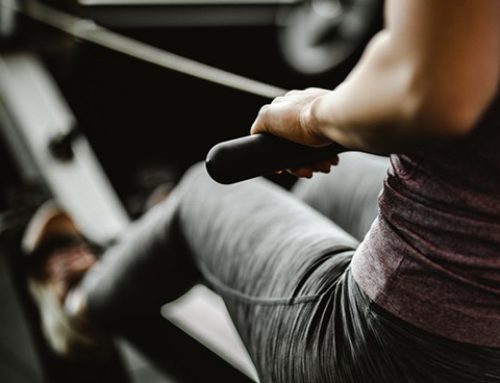Run Faster and Lift Better by Learning How to Breathe
One of the great things about breathing (other than keeping you alive) is that you don’t have to think about it. It’s an unconscious activity; you just do it. But a number of experts say that conscious, controlled breathing can seriously improve your performance, helping you run faster and lift heavier weights. Here’s how.
Running
Who Says It: Budd Coates, four-time qualifier for the U.S. Olympic Marathon Trials and author of Running on Air: The Revolutionary Way to Run Better by Breathing.
How To Do It: Time your breaths to a five-step pattern, breathing in for three paces and out for two. This is a good pattern for easier, endurance-building runs. If you can’t maintain this rate, slow down. You’re running too fast. For speed work and other fast-paced running, try a 3-step pattern—in for two steps, out for one.
Why It Works: Rhythmic breathing itself won’t make you faster, but it allows you to become faster because you learn to train more efficiently. Learning to inhale for longer than you exhale helps deliver more oxygen to your muscles so you can train at a higher intensity. Performed appropriately, rhythmic breathing can also help you avoid injury. Most people inhale and exhale for the same duration when walking and running—which is a problem, since the foot you land on when exhaling receives the most stress. Timing your breaths so that you start your inhalation on alternating legs reduces the chance you’ll suffer leg injuries as you log more miles.
Practice: If you struggle with keeping rhythm as you run, try this. Lie on your back and place one hand on your stomach and the other on your chest. Inhale deeply, feeling the air flow deep into your belly. Count your inhales and exhales. Begin tapping your feet to simulate your strides. Once you have the hang of it lying down, stand up and continue breathing and counting while walking. Gradually increase your pace until you’re maintaining the pattern while running.
Strength Training
Who Says It: Shaun Sterling, strength coach, IFA-certified personal trainer, yoga instructor and co-owner of Bodywize Athletic Development in Warrensville Heights, Ohio.
How To Do It: Focus on taking deep abdominal breaths during the lowering phase of a lift, then forcefully push the air out when pressing or pulling the weight up. For example, when performing the Bench Press, slowly breathe in as you lower the bar to your chest, then expel the breath as you push the bar away from your body.
Why It Works: When you’re training hard in the gym, there’s a tendency to start taking short, shallow breaths through your mouth. This elevates your heart rate and flares up your nerves, which can over-stimulate your body. Also, it allows you to use only around a third of your total lung capacity. Deep abdominal breaths fill your lungs more completely from the bottom up, sending more oxygen into your bloodstream, where your muscles can use it as a source of fuel. You’ll be able to work harder, get a better quality workout and make notable performance gains. Bonus: Your body will burn fat faster, because it’s using more oxygen.
Practice: Segmented breathing can teach you how to better control your breath while lifting. Choose a bodyweight exercise like the Push-Up. Simultaneously lower your chest to the ground as you inhale through your abdomen. Pause at the bottom, holding your breath for a five-count. Then simultaneously push yourself up and exhale. Perform two sets of 10 reps, focusing on a different segment of your breathing—the inhale, hold, or exhale—with each rep.
RECOMMENDED FOR YOU
MOST POPULAR
Run Faster and Lift Better by Learning How to Breathe
One of the great things about breathing (other than keeping you alive) is that you don’t have to think about it. It’s an unconscious activity; you just do it. But a number of experts say that conscious, controlled breathing can seriously improve your performance, helping you run faster and lift heavier weights. Here’s how.
Running
Who Says It: Budd Coates, four-time qualifier for the U.S. Olympic Marathon Trials and author of Running on Air: The Revolutionary Way to Run Better by Breathing.
How To Do It: Time your breaths to a five-step pattern, breathing in for three paces and out for two. This is a good pattern for easier, endurance-building runs. If you can’t maintain this rate, slow down. You’re running too fast. For speed work and other fast-paced running, try a 3-step pattern—in for two steps, out for one.
Why It Works: Rhythmic breathing itself won’t make you faster, but it allows you to become faster because you learn to train more efficiently. Learning to inhale for longer than you exhale helps deliver more oxygen to your muscles so you can train at a higher intensity. Performed appropriately, rhythmic breathing can also help you avoid injury. Most people inhale and exhale for the same duration when walking and running—which is a problem, since the foot you land on when exhaling receives the most stress. Timing your breaths so that you start your inhalation on alternating legs reduces the chance you’ll suffer leg injuries as you log more miles.
Practice: If you struggle with keeping rhythm as you run, try this. Lie on your back and place one hand on your stomach and the other on your chest. Inhale deeply, feeling the air flow deep into your belly. Count your inhales and exhales. Begin tapping your feet to simulate your strides. Once you have the hang of it lying down, stand up and continue breathing and counting while walking. Gradually increase your pace until you’re maintaining the pattern while running.
Strength Training
Who Says It: Shaun Sterling, strength coach, IFA-certified personal trainer, yoga instructor and co-owner of Bodywize Athletic Development in Warrensville Heights, Ohio.
How To Do It: Focus on taking deep abdominal breaths during the lowering phase of a lift, then forcefully push the air out when pressing or pulling the weight up. For example, when performing the Bench Press, slowly breathe in as you lower the bar to your chest, then expel the breath as you push the bar away from your body.
Why It Works: When you’re training hard in the gym, there’s a tendency to start taking short, shallow breaths through your mouth. This elevates your heart rate and flares up your nerves, which can over-stimulate your body. Also, it allows you to use only around a third of your total lung capacity. Deep abdominal breaths fill your lungs more completely from the bottom up, sending more oxygen into your bloodstream, where your muscles can use it as a source of fuel. You’ll be able to work harder, get a better quality workout and make notable performance gains. Bonus: Your body will burn fat faster, because it’s using more oxygen.
Practice: Segmented breathing can teach you how to better control your breath while lifting. Choose a bodyweight exercise like the Push-Up. Simultaneously lower your chest to the ground as you inhale through your abdomen. Pause at the bottom, holding your breath for a five-count. Then simultaneously push yourself up and exhale. Perform two sets of 10 reps, focusing on a different segment of your breathing—the inhale, hold, or exhale—with each rep.












